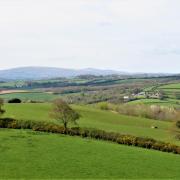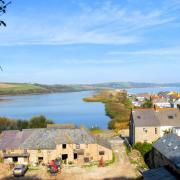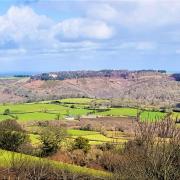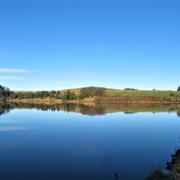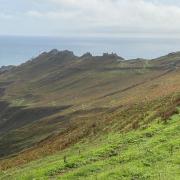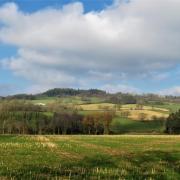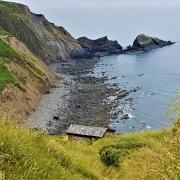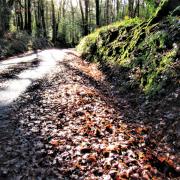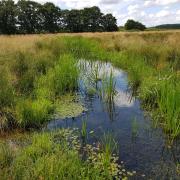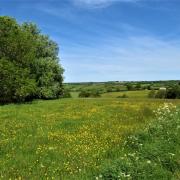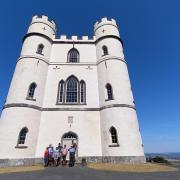A wonderfully scenic, family walk for Easter, with SIMONE STANBROOK-BYRNE
We all know walking is good for us, aerobic exercise in the fresh air. But what’s good for the heart and the soles is, in this case, supremely good for the soul too.
This walk shows the South Hams at its poetically lovely best: magical views across boat-dotted water, where winding creeks poke their fingers inland through velvety, patchwork farmland. Way inland, the heights of Dartmoor may be glimpsed. There is an ever-present sense of things nautical.

The route is short, to accommodate everyone during the Easter holidays, and follows a network of National Trust permissive paths. Take your time and make the most of frequent benches from which to drink it all in. Refreshing in every sense.
Route
1.
At the ‘lane’ end of the car park a fingerpost, signed for Lincombe and Snapes Point, directs up a short stretch of track into a field. Follow this, and as soon as you arrive in the field, pause to take in the panorama.
To the right is the Salcombe end of the Kingsbridge Estuary, part of the South Devon Area of Outstanding Natural Beauty – it’s easy to see why. Although always referred to as an estuary, it is, in fact, not a true estuary but a ‘ria’ – a ‘drowned’ valley with no major river running into it, just plentiful small streams. The detail doesn’t detract.
In 180m, at a three-way fingerpost, go left through a gate to be confronted by more fabulous scenery; the water leads the eye inland, away from the estuary’s mouth. Walk down the field beside the left-hand hedge; Lincombe Boatyard soon comes into view some way below.
Down in the field corner is another fingerpost; turn right here, towards Snapes Point, staying in the same field.

2.
The path travels along the lower edge of the field, with the boatyard down to the left. Looking north up the estuary (when the hedge permits) there are two distinct settlements: Kingsbridge is the larger, to the left, and to the right is West Charleton, its church standing slightly apart at the west end of the village.
The left-hand hedge meanders a bit as it drops downhill; the clinking sound of rigging from the boats below wafts up the hillside. At the end of the field go through a gate with a yellow-arrowed post beyond. Turn sharp left and walk down the field towards Tosnos Point. The hedgerows here are dense and good for birds – we saw a cirl bunting, a fairly rare bird but one that frequents the South Hams where many National Trust farms are well-managed for wildlife.
3.
The path levels out and swings right, water down to the left and farmland to the right with a line of statuesque pines on the skyline. Depending on the state of the tide, mudflats may be exposed, a good place for wading birds to seek their lunch.
At the end of the field the path rises to a gate with a three-way fingerpost beyond. Keep straight on towards the headland of Snapes Point, the way is well-trodden and generally follows the left-hand hedge, although sheep’s paths entice us upwards. The sheep have made good use of the fences as scratching posts, leaving woolly ‘kebabs’ clinging to the wire.

Continue, generally following the left-hand boundary with the field sloping up to the right – anyone with a short right leg will find this more comfortable. Just over 400m through this field you draw level with a wooden field gate down to the left, and the way ahead narrows between gorse, here veer right up the field, walking below a beautifully shaped, multi-trunked tree, with scrubby thickets of gorse to your left. This path reaches some benches, well-placed to enjoy the superb outlook from this headland. If you climb the slope a few metres behind the further bench there are 360-degree views, back along the estuary as well as seawards.
4.
This latter bench is a wooden plank on stone piles. To continue the walk, head downhill, away from this bench to the bottom fenceline above the estuary and seek out the small gate in the fence that leads out to a flight of steps. I was walking this route with a National Trust ranger who wanted me to draw attention to the beautifully jointed chestnut posts that form the wooden banister beside these steps….
At the bottom turn right along the track, enjoying gorgeous views across to the vibrant town of Salcombe with its cats’-cradle of yacht masts around Island Quay. From here the estuary runs seawards, towards the distant Mew Stones off Bolt Head.
For the birders, an unusual sighting a couple of winters ago was an albino great northern diver just offshore here and, very, very occasionally, an osprey may waft past.
Follow the track inland, initially walking above Batson Creek. Watch out for flocks of linnets along here, little brownish birds who bounce along the hedgerows. A track marked ‘private’ leads left to privately owned Snapes Manor, very historic, but invisible from here. Some of it dates back to the 12th century.

5.
After about half-a-mile ignore a footpath arriving through fields from the right and stay on the track, climbing gently. In another 450m a small gate leads right off the track and deposits you back in the car park.

Compass Points
Directions to start point and parking: The car park is accessed along small lanes north of Salcombe. When you reach a fork in the lane, with Lincombe Farm and Boatyard to the left, keep right and this leads to the National Trust car park for Snapes Point. Nearby postcode: TQ8 8NQ; grid ref: SX739401
Map: OS Explorer OL20, South Devon 1:25 000
Terrain: Field paths and tracks
Distance: 2½ miles
Dog friendliness: Animals grazing, no roads
Exertion: Easy with some gradual uphills
Refreshments: Nothing en route but many options in Salcombe and Kingsbridge

While you’re here…..five things to do while you’re in the area
1. Take a picnic: There are no refreshment stop en route but there are plentiful view-rich benches to enjoy. If you’re lucky (we weren’t) you may find the picnic table above the car park empty and waiting for you.
2. Salcombe has so much to attract, not least the glorious National Trust property of Overbeck’s, one-time home of eccentric inventor, Otto Overbeck. One of his inventions, which should have done well, was a nutritious comestible, which he called ‘Carnos’, discovered as a ‘waste’ product whilst he was working at a brewery. But fortune did not smile on Otto as far as Carnos was concerned and the patent he had taken out on it expired. Soon afterwards something remarkably similar appeared on the market – branded Marmite.
3. Kingsbridge, likewise, has a lot on offer. Perhaps visit the Cookworthy Museum, which celebrates its 50th birthday this year. The museum is named after William Cookworthy, born in Kingsbridge, who discovered a form of naturally occurring, decomposed granite from which the English china clay industry was developed.
4. Get on the water with the Kingsbridge to Salcombe Ferry. This usually runs from April to October and sometimes they offer coastal cruises
5. Beaches: if sand appeals this area has some lovely beaches, though they can be busy. On the east side of the estuary is the area around Mill Bay, and on the west side are North Sands and South Sands, on the edge of Salcombe.







